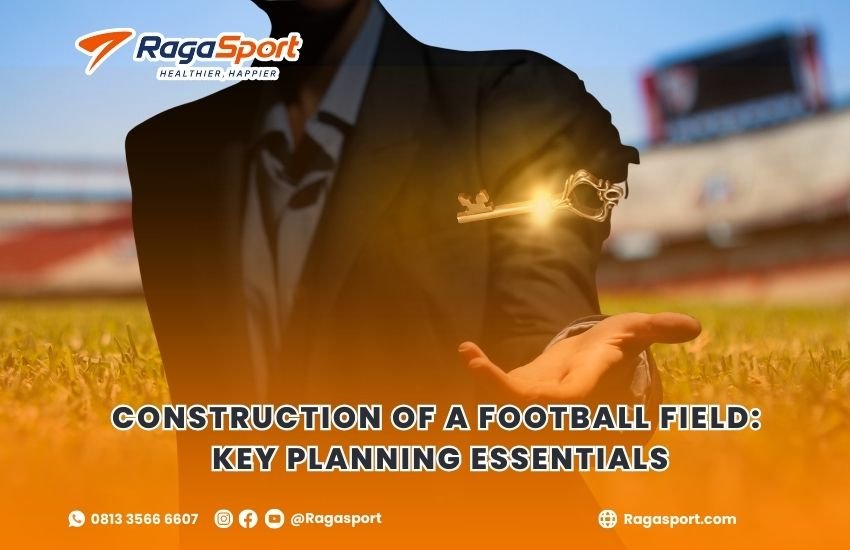The construction of a football field is a complex yet rewarding project. Whether for a school, sports academy, or professional club, a well-designed and properly built football field enhances safety, performance, and long-term usability. From site preparation to surface selection and drainage installation, each element plays a vital role in ensuring a successful outcome.
This article explores the key planning essentials in the construction of a football field, including technical specifications, surface options, drainage design, and estimated costs.
Table of Contents
1. Choosing the Right Site
Site selection is a critical first step in football field construction. An ideal site must meet several basic conditions:
- Sufficient space for the full field and surrounding safety zones
- Flat or slightly sloped terrain for ease of grading
- Stable soil that can support a layered base
- Accessibility for equipment, maintenance, and spectators
Before development begins, a geotechnical survey should be conducted to analyze the soil’s bearing capacity, drainage potential, and composition. This data is used to guide the foundation and drainage design.
2. Field Size and Layout Standards
For international matches under FIFA regulations, the recommended field size is:
- Length: 105 meters
- Width: 68 meters
For training or community use, flexible dimensions may range from 90–120 meters in length and 45–90 meters in width. Regardless of size, it’s essential to include a minimum buffer of 3 meters around the perimeter to ensure player safety and allow maintenance access.
Markings such as penalty areas, center circles, and corner arcs must follow FIFA or national regulations depending on the intended use of the field.
3. Selecting the Playing Surface
One of the most important decisions in the construction process is choosing between natural grass and synthetic turf.
Natural Grass
- Traditional, soft underfoot, and preferred for elite-level play
- Requires regular watering, mowing, fertilizing, and reseeding
- Can suffer from overuse, weather damage, and inconsistent surface quality
Synthetic Turf
- Durable, weather-resistant, and ideal for high-traffic environments
- Low maintenance: no watering, mowing, or chemical treatment
- Higher upfront installation cost but consistent year-round playability
The final choice depends on your budget, maintenance capacity, and usage frequency. Some facilities also opt for hybrid systems combining both materials.
4. Building a Reliable Drainage System

Without proper drainage, even the best football field will deteriorate quickly. Drainage ensures that water is removed efficiently from the surface and sublayers, keeping the field playable in all conditions.
A typical drainage system includes:
- Surface grading with a 1–2% slope to guide water away from the field
- Subsurface drains (e.g., perforated pipes laid in trenches)
- Crushed stone layers that promote filtration and prevent flooding
- Geotextile membranes to prevent soil migration and clogging
Synthetic turf fields often feature integrated drainage cells or horizontal drainage mats beneath the turf layer.
5. Constructing the Subbase and Foundation
A strong, well-draining foundation is essential for both natural and synthetic fields. A standard layered subbase may include:
- Excavation: Remove topsoil and vegetation to create a level surface
- Compacted subgrade: Stabilized native soil or imported fill
- Geotextile separator: Prevents mixing of stone and soil layers
- Gravel base: Supports drainage and provides structural strength
- Leveling layer: Sand or fine stone to fine-tune the surface grade
If synthetic turf is used, an additional shock pad may be installed above the leveling layer to reduce impact and improve player safety.
6. Irrigation and Maintenance Considerations
For natural grass fields, an automatic irrigation system is a must. Strategically placed sprinkler heads should deliver even water coverage. Rain sensors and timers help optimize water use and prevent over-irrigation.
Regular maintenance tasks include mowing, aeration, topdressing, and pest control. Synthetic turf, while low maintenance, still requires routine brushing, infill top-up, and periodic disinfection to keep the surface clean and level.
Long-term maintenance planning is essential to protect the field’s usability and extend its service life.
7. Lighting, Access, and Surrounding Facilities
Modern football fields often include LED lighting systems, enabling nighttime training or competition. Lighting should meet recommended lux levels and be evenly distributed to reduce shadows and glare.
Surrounding infrastructure may include:
- Fencing for safety and security
- Bleachers or stands for spectators
- Changing rooms, restrooms, and equipment storage
- Access roads for emergency vehicles and maintenance crews
Designing a complete facility ensures a better experience for players, coaches, and fans.
8. Budget Breakdown for Football Field Construction
Estimated construction costs depend on surface type, site conditions, and infrastructure. Here’s a general breakdown (in Indonesian Rupiah):
| Component | Natural Grass | Synthetic Turf |
|---|---|---|
| Site Preparation | 20 – 30 million | 20 – 30 million |
| Subbase & Drainage | 50 – 100 million | 70 – 130 million |
| Surface Installation | 60 – 100 million | 300 – 500 million |
| Irrigation System | 25 – 40 million | Not Required |
| Lighting | 80 – 150 million | 80 – 150 million |
| Infrastructure | 40 – 70 million | 40 – 70 million |
| Total Estimate | 275 – 490 million | 510 – 880 million |
These are average ranges. Prices may increase with advanced materials, custom designs, or special geographic conditions.
9. Why You Should Hire a Professional Contractor
Football field construction is highly specialized. Hiring a contractor with experience in sports infrastructure ensures compliance with international standards and avoids costly errors. Look for:
- Proven portfolio of completed fields
- Familiarity with FIFA or local field requirements
- Warranty and after-sales maintenance support
- Transparent timelines and cost estimates
A trusted contractor manages the project from design to handover, guaranteeing both quality and accountability.

Ready to Build a Professional Football Field?
Let Raga Sport turn your vision into reality with expert construction, top-quality materials, and a field that meets every standard.
👉 Explore our projects at ragasport.com
📲 Chat with our team now via WhatsApp: Click Here

